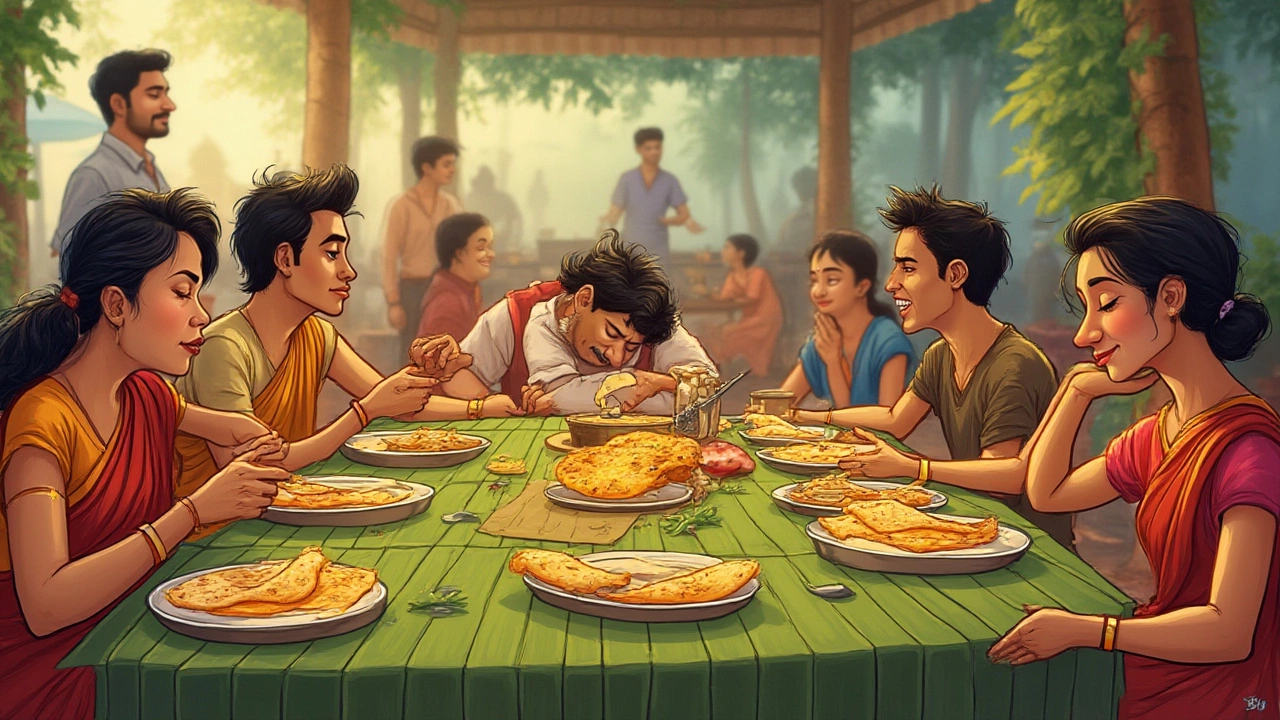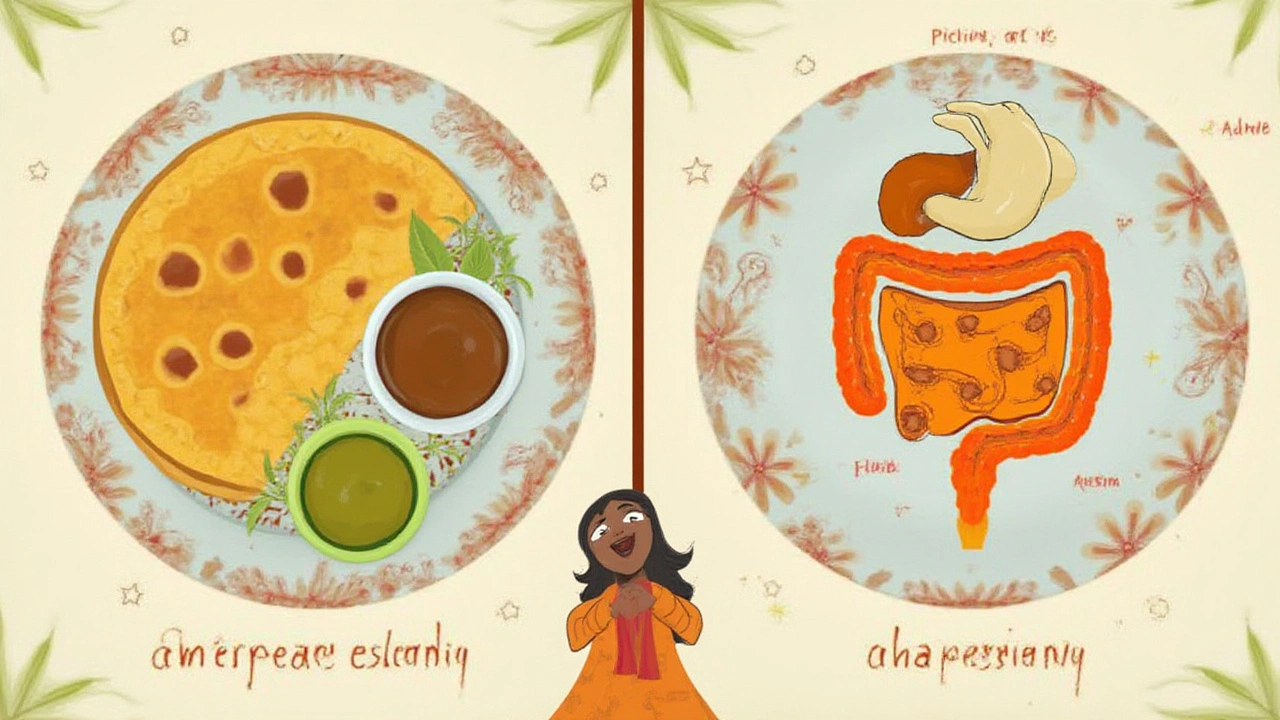Ever noticed how, after a delightful dosa breakfast or dinner, you can barely resist taking a nap? You’re not alone. It almost feels like the fluffy center of the dosa has cast a sleepy spell. Anyone who’s grown up on South Indian food knows this familiar haze—yet, few people stop to ask why it happens. There are some real, science-backed reasons hiding under those folds of golden-brown dosa. And once you know them, you might rethink your next nap and even tweak a few habits to keep your energy up.
What in a Dosa Makes You Sleepy?
Let’s get straight into the heart of the matter. A classic dosa is made mainly from a fermented mixture of rice and urad dal (a type of lentil). Fermentation makes it delicious, slightly tangy, and easy to digest. But, that mix of carbohydrates and protein does some serious things to your body after you eat. When you gobble up a couple of hot dosas, you’re getting a hefty portion of carbohydrates. According to nutrition databases, a standard plain dosa (one piece) can have anywhere between 120 and 180 calories, with most of those coming from simple and complex carbs.
This brings us to blood sugar. Carbs are broken down into glucose during digestion. When your blood is flooded with glucose, your body reacts by releasing insulin. Insulin does many things, but one sneaky job is to influence how much tryptophan (an amino acid) reaches your brain. Why does that matter? Well, tryptophan helps your body make serotonin, and then melatonin—two chemicals that make you feel good, relaxed, and eventually, sleepy.
This whole chain of events kicks in pretty fast. Studies out of Hyderabad’s National Institute of Nutrition in 2021 found spikes in “postprandial somnolence”—that’s the fancy term for ‘wanting to curl up and nap after eating’—among people eating high-carb comfort foods like dosa, idli, and white rice. Dosai (the plural in Tamil) rank right at the top of this easy-to-digest, carb-heavy pile.
But that’s not the whole story. Fermentation makes the carbs in dosa even easier for your body to absorb. All that means is your blood sugar and insulin can go up faster—a recipe for a sleepy afternoon, especially if you gobbled your dosa in record time. The combination of comfort, warmth, and soft textures only adds to the sleep-inducing effect, tricking your nervous system into winding down. No wonder dosas are such a breakfast staple—they set you up to chill.
Let’s not forget accompaniments. Coconut chutney and sambar might seem like they wouldn’t matter, but sambar has some protein and fiber, which can slow down the sugar spike. However, if you eat more chutney (which is mostly coconut and fat), you give your stomach extra work. So, heavy dosas with lots of coconut chutney and potato filling? That’s a nap on a plate.
| Component | Amount |
|---|---|
| Calories | 120–180 kcal |
| Carbohydrates | 22–30 g |
| Protein | 3–4 g |
| Fat | 2–3 g |
| Sodium | 150 mg |
Combine all this with the typical rush of the morning, and it makes sense: your body feels both the quick fuel and the need for recovery. It’s not all in your head—your chemistry is leading you straight to that sofa.

The Science of Digestion and Post-Meal Drowsiness
Now let’s zoom out a bit. Dosa isn’t the only food that can make you feel this way. The body begins a routine every time we eat, but certain foods speed things up. Here’s what’s happening inside you after devouring a crispy dosa:
- Digestion draws blood to your stomach and intestines to help break down your meal.
- Your other muscles and your brain get slightly less blood flow, which makes you feel dull and lazy.
- Alongside the insulin spike, there’s a release of satiety hormones like cholecystokinin (CCK) and peptide YY. Both tell your body, “Time to rest!”
- The combo of rice and urad dal, especially after the magic of fermentation, speeds up sugar absorption so you feel a sugar high, then a fast slump.
To put it into perspective, Japanese researchers in 2022 found that people who ate high-glycemic (quickly absorbed sugar) breakfasts had slower reaction times and more errors in cognitive tasks within an hour after eating. Dosa rates as a high-to-medium glycemic index food, so it fits this pattern. Plus, people who skip breakfast or eat very light sometimes don’t notice the sleepiness at all, because their brains don’t get this sudden energy rush—or crash.
Timing also matters. If you eat dosas late at night or too close to bedtime, your digestion is busy working as your body tries to rest. This can make you toss and turn, delaying real deep sleep—but can still cause that initial drowsy crash that makes you want to just “rest your eyes.”
Let’s also talk about the culture of eating dosa. For many families, a dosa meal is unhurried—the food is fresh, often eaten with family chatter, and followed by tea, filter coffee, or even a chat on the balcony. Some folks naturally “rest” after bigger meals, so you’ve got the perfect setup for your body and brain to collaborate for a nap attack.
Like I mentioned before, accompaniments matter. Pickles or spicy chutneys can rev up your digestion a notch, sometimes making you more alert—but if coconut or peanut dominates the plate, fat digestion slows everything down. And if you reach for a sweetened coffee right after, your insulin continues to rise, keeping that sleepy feeling firmly with you.
Here’s the kicker—your own sleep the night before plays a big role too. If you were up late, a dosa meal can be the last straw. Some people even use a heavy dosa breakfast as an “excuse” to nap, building it into their weekend routine.
What else? The so-called “food coma” is a real thing. You’ll find the same story with pancakes, big rice breakfasts, or even warm, cheesy pizza. When you combine multiple factors—simple carbs, fat, quick eating, and tiredness—it’s no contest: sleepiness wins.

How to Enjoy Dosa Without the Nap Attack
If you love dosas but don’t want to snooze your way through the rest of your day, don’t worry. A few easy tweaks can go a long way:
- Balance your meal with protein and fiber. Add a handful of sprouts to your dosa, or pair it with more sambar and less chutney for lasting energy.
- Try multigrain or millet dosa instead of just white rice batter—millets digest more slowly, making your blood sugar rise gradually instead of spiking up.
- Avoid loading up on extra potato filling if you’re eating dosas for lunch—you’ll feel fuller but also sleepier.
- Take a short, gentle walk after eating rather than lying down immediately. A Japanese study in 2023 showed that a post-meal stroll for just 10 minutes reduced drowsiness and improved focus up to two hours later.
- If you’re eating dosa at a restaurant, opt for plain or ragi dosa and load up on tangy tomato chutney or sambar for more fiber and less fat-induced fatigue.
- Drink water or mild buttermilk with your dosa instead of super-sweet coffee or tea, keeping your digestion on track.
For people with diabetes or anyone sensitive to big sugar swings, dosa need not be off the table. Just swap in whole grains or oats, increase the urad dal content, or sneak in some grated vegetables. Not only will this help you skip the nap, but it’ll also keep your gut and energy happy longer.
Curious if your dosa nap is ‘normal’? There’s actually no “one-size-fits-all” answer. Some folks have a naturally higher sensitivity to sugar and carb swings, while others barely notice. If you’re finding that you crash too often, it might be a cue to slow down, chew your food thoroughly, and enjoy your meal mindfully. Fast eating speeds up the sugar dump and the nap chase—so take your time!
Hey, a nap after dosa isn’t always a bad thing. In some ways, it’s the body’s way of relaxing and digesting well. But if you’re juggling work calls or meetings after breakfast, a few smart choices can help keep you sharp.
Next time you slice up a dosa, you’ll know exactly why sleepiness creeps in—your body chemistry is just doing its thing. Now you’ve got the lowdown and handy tricks to dodge the doldrums and enjoy your dosa without the drowsiness. Sweet dreams, or sweet productivity—the choice is all yours.
